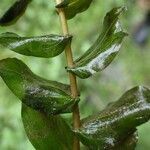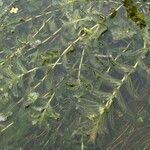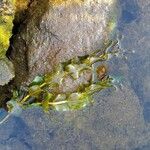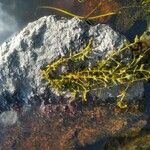Vertical shoots short-lived, seasonal; stem filiform to slender, terete, to 6 m long, much branched, particularly in the upper part; horizontal shoots slender to robust, perennial, branched, producing dormant lateral multiple winter buds. Floating leaves always absent; submersed leaves broadly ovate to broadly lanceolate, sessile, clasping the stem, lamina 20-60(-120) by 10-35(-60) mm, 11-25-veined with 2-4 more conspicuous side-veins, margin minutely dentate, sometimes undulate, base cordate, apex obtuse; stipules axillary, convolute, 10-20 mm, early decaying. Spikes cylindrical, contiguous, 10-30 mm; peduncle 20-50 mm, not thickened. Flowers numerous, with 4 carpels. Fruits obliquely oblong, 2-3 mm, unkeeled, with a backwards curved beak. Stem anat-omy: Stele of trio type with one bundle in central position. Endodermis without thickening or of faint O-type. Interlacunar bundles absent, subepidermal bundles absent or few. Pseudo-hypodermis absent. Chromosome number: 2n = (26), 52.
Plants perennial, submerged in fresh water. Rhizome unspotted, terete, slender. Stems terete, 0.5-2.5 mm in diam., densely branched at upper part. Stipules axillary, convolute, 3-22 mm, membranous, evanescent; leaves sessile, lanceolate to broadly ovate, orbicular-ovate, or ovate-oblong, 3-5-veined, with narrow rows of lacunae bordering midvein, base cordate and amplexicaul, margin minutely denticulate, apex obtuse or rounded. Spikes usually contiguous and cylindric, with 4-7 whorls of opposite flowers; peduncles 2-11 cm. Carpels 4. Fruit obovoid, 2.5-4.5 mm, abaxial keels 3, with a slightly sharp midvein and 2 indistinct lateral keels, with a short beak at tip. Fl. and fr. May-Oct. 2n = 52.
Stem slender, to 2.5 mm, often much branched; internodes mostly 1–3 cm; lvs all submersed, ovate to suborbicular, 1–5(–9) cm × 5–25(–40) mm, mostly broadly rounded or obtuse, sessile, with cordate-clasping, often perfoliate base, delicately 3–25-veined, 3(5) veins stronger; stipules axillary, free, evanescent; peduncles 1–7 cm, about as thick as the stem, not clavate; spikes dense, cylindric, 1–4.5 cm; frs obliquely obovoid, 1.6–3 mm (including the short beak), very shallowly pitted, with 3 obscure dorsal keels, or keelless; 2n=52. Ponds and slow streams; irregularly cosmopolitan, in Amer. from Nf. and Ont. to N.C. and O., disjunct along the Gulf Coast.
Submerged, rhizomatous, aquatic perennial herb. Stem terete, to 3 m long; turions absent. Stipules convolute, free from base of leaf blade. Leaves sessile, narrow to broadly lanceolate, 2–6 cm long, 0.5–1 cm wide, perfoliate at base; margins crisp for most of blade, minutely dentate near apex; apex obtuse, rarely acute; veins 3–5. Inflorescence terminal or axillary, a capitulate or shortly cylindric spike. Peduncles erect, rarely recurved. Fruit abaxially rounded, laterally compressed, 2.5–3.5 mm long (including beak), with 3 crenulate dorsal keels.
A herb that grows in water. It has rhizomes. The stems can be branched. The leaves are under the water and do not have leaf stalks. They are broadly sword shaped and vary in size and shape. They can be 2-6 cm long and 1.5-2 cm wide.





